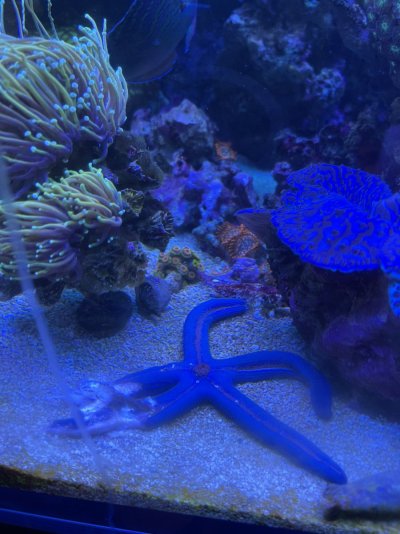I previously cared for a blue linckia that lived in my tank for over a year. Not long term by any stretch as these are very difficult animals to care for in a home tank. I did eventually lose it for what I think was just a maturity issue when I upgraded my tank and had to replace a signficant amount of rock which may have limited the food source on the rocks. Ancedotal of course as we don't know what they really eat, but only guess film algae and other related sources on surfaces. Fast forward. A new reefer that I know impulse bought one that was huge for his tiny tank. This is likely doom for the starfish so he gave it to me to care for it recognizing it might have a better chance in my tank.
Here's the situation: When we introduced it to my tank after acclimating of course; power head blew it into a giant carpet nem which quicky grabbed 2 of the starfish's legs. Simply wouldn't let go and I eventually freed the starfish. Damage done of course and the carpet stung the heck out of the starfish. That was two days ago and today I saw the legs for the first time. Severly injured. Question is what action should I take if any. Since starfish regrow legs, should I amputate the 2 injured legs to limit the spread of any infection, or just leave it be. See photos. I remember reading lots of cases where folks have amputated chocolate chip starfish legs as food for shrimp. Let's not go down that path for now, but focus on action to rescue this one.
Should I amputate in hopes to save? Any other actions?
Here's the situation: When we introduced it to my tank after acclimating of course; power head blew it into a giant carpet nem which quicky grabbed 2 of the starfish's legs. Simply wouldn't let go and I eventually freed the starfish. Damage done of course and the carpet stung the heck out of the starfish. That was two days ago and today I saw the legs for the first time. Severly injured. Question is what action should I take if any. Since starfish regrow legs, should I amputate the 2 injured legs to limit the spread of any infection, or just leave it be. See photos. I remember reading lots of cases where folks have amputated chocolate chip starfish legs as food for shrimp. Let's not go down that path for now, but focus on action to rescue this one.
Should I amputate in hopes to save? Any other actions?














